No matter where we travel visiting the local churches and cathedrals always ranks high on our list of things to do. It is not for religious reasons but rather for the architecture and artistic value of these iconic sites. A place of worship was often the first educational institutions in any community and the social centre in many medieval towns. Much of the art of the era was produced to be housed in the churches, working to educate and inspire the congregation as much as the message heard from the clergy. Later they become the preferred location for remembrance of those figures that changed or influenced local history, or fought to preserve their freedoms. Sculptures, shrines and tombs now embellish the naves or chapels of most large cathedrals.
So in no particular order, and for your consideration, here are our top 5 cathedrals in the United Kingdom.
- Westminster Abbey, London
If you follow the Royals you have seen Westminster Abbey on television whether it was for a wedding or a funeral. It is far more impressive in person. The entrance fee is one of the highest for a religious institution but well worth it. They also offer an excellent, free audio guide, narrated by Jeremy Irons, that helps to direct your visit. The Abbey is the final resting place of Royals throughout the centuries as well many of the greatest minds of recorded time. Be sure to browse through the notable names in the Poet’s Corner, dedicated to countless writers such as Chaucer, Byron, Dickens and Carroll. Then find your way to Scientist’s Corner where you will find monuments to some of the greatest scientists of recent history, such as Newton and Darwin. This is notable as religion and science have often been at odds over the centuries. Just shortly after our visit Westminster Abbey became the final resting place for the great Stephen Hawking.
- Durham Cathedral, Durham
 This is a beautiful cathedral founded in 1093 and offering an excellent example of Norman architecture. It was originally built to house the bones of Saint Cuthbert from Lindisfaine. There are guided tours offered and I would recommend taking one if it fits your schedule. The guides are locals who have an attachment to the cathedral that drives their knowledge and enthusiasm. Our guide was also part of the choir and gave us all goose bumps when she sang a few notes in the acoustically perfect chapel.
This is a beautiful cathedral founded in 1093 and offering an excellent example of Norman architecture. It was originally built to house the bones of Saint Cuthbert from Lindisfaine. There are guided tours offered and I would recommend taking one if it fits your schedule. The guides are locals who have an attachment to the cathedral that drives their knowledge and enthusiasm. Our guide was also part of the choir and gave us all goose bumps when she sang a few notes in the acoustically perfect chapel.
- York Minster, York
York Minster is the largest Gothic church north of the Alps. Again we took advantage of a tour with a local that helped to bring to life the history of this cathedral. Known for its stained glass, he discussed the recent arduous process of cleaning and restoring many of the windows, helping us to understand the dedication and expense that does into maintaining such a structure. We were also guided through the history of the area as we explored the naves and chapels dedicated to the men and women who fought for their country.
- Paul’s Cathedral, London
 I remember St. Paul’s as the site of the wedding of Prince Charles and Princess Diana. Wed the same year as Ken and I, that event started my ongoing connection to the younger Royals. We joined a tour with a local gentleman who had researched and written books about the history of the cathedral and who brought this church to life in a way we would never have achieved on our own. At one point the tour paused for a prayer offered by the clergy and I was moved by the respect and quiet presented by a large and diverse group of tourists.
I remember St. Paul’s as the site of the wedding of Prince Charles and Princess Diana. Wed the same year as Ken and I, that event started my ongoing connection to the younger Royals. We joined a tour with a local gentleman who had researched and written books about the history of the cathedral and who brought this church to life in a way we would never have achieved on our own. At one point the tour paused for a prayer offered by the clergy and I was moved by the respect and quiet presented by a large and diverse group of tourists.
- Giles Cathedral, Edinburgh

The ornate Scottish crown steeple from 1495 marks the skyline of Edinburgh and Scotland’s most important church. Its interior pays tribute to hundreds of years of distinguished Scots who formed this proud country. The religious reformer John Knox, and founder of Scottish Presbyterianism, preached here in the 16th century. Visit the Chapel of the Knights of the Thistle to see beautiful wood carved figures, including a cherub playing the bagpipes in heaven.
Honourable Mention – Bath Abbey, Bath
